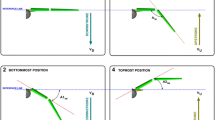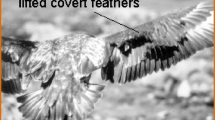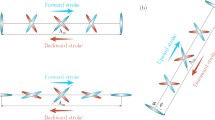Abstract
The preliminary design of a biologically inspired flapping UAV is presented. Starting from a set of initial design specifications, namely: weight, maximum flapping frequency and minimum hand-launch velocity of the model, a parametric numerical study of the proposed avian model is conducted in terms of the aerodynamic performance and longitudinal static stability in gliding and flapping conditions. The model shape, size and flight conditions are chosen to approximate those of a gull. The wing kinematics is selected after conducting an extensive parametric study, starting from the simplest flapping pattern and progressively adding more degrees of freedom and control parameters until reaching a functional and realistic wing kinematics. The results give us an initial insight of the aerodynamic performance and longitudinal static stability of a biomimetic flapping UAV, designed at minimum flight velocity and maximum flapping frequency.























Similar content being viewed by others
References
de Croon GC, Groen MA, De Wagter C, Remes B, Ruijsink R, van Oudheusden BW (2012) Design, aerodynamics and autonomy of the DelFly. Bioinspir Biomim 7:025003
Prosser D, Basrai T, Dickert J, Ratti J, Crassidis A, Vachtsevanos G (2011) Wing kinematics and aerodynamics of a hovering flapping micro aerial vehicle. In: Aerospace conference, 2011 IEEE, pp 1–10, 5–12
Lee JS, Kim DK, Lee JY, Han JH (2008) Experimental evaluation of a flapping wing aerodynamic model for MAV applications. In: SPIE 15th annual symposium smart Structures and material, pp 69282M/1–69282M/8
Han JH, Lee JS, Kim DK (2009) Bio-inspired flapping UAV design: a university perspective. Proceedings of SPIE - The International Society for Optical Engineering, vol 7295:72951I
Maeng JS, Park JH, Jang SM, Han SY (2013) A modeling approach to energy savings of flying Canada geese using computational fluid dynamics. J Theor Biol 320:76–85
Hubel T, Tropea C (2009) Experimental investigation of a flapping wing model. Exp Fluids 46:945–961
Send W, Fischer M, Jebens K, Mugrauer R, Nagarathinam A, Scharstein F (September, 2012) Artificial hinged-wind bird with active torsion and partially linear kinematics, 28th Congress of the International Council of the Aeronautical Sciences, 23-28
Parslew B, Crowther W (2010) Simulating avian wingbeat kinematics. J Biomech 43:3191–3198
Nakata T, Liu H, Tanaka Y, Nishihashi N, Wang X, Sato A (2011) Aerodynamics of a bio-inspired flexible flapping-wing micro air vehicle. Bioinspir Biomim 6:045002
Tsai B, Fu YC (2009) Design and aerodynamic analysis of a flapping-wing micro aerial vehicle. Aerosp Sci Technol 13:383–392
Grauer J, Hubbard J (2009) Modeling of ornithopter flight dynamics for state estimation and control. In: 2010 American control conference, June 30–July 02, Baltimore
Thomas A, Taylor G (2001) Animal flight dynamics I. Stability in gliding flight. J Theor Biol 212:399–424
Thomas A, Taylor G (2002) Animal flight dynamics II. Longitudinal stability in flapping flight. J Theor Biol 214:351–370
Mueller T, DeLaurier J (2003) Aerodynamics of small vehicles. Ann Rev Fluid Mech 35:89–111
Shyy W, Lian Y, Tang J, Viieru D, Liu H (2007) Aerodynamics of low Reynolds number flyers, Cambridge aerospace series, Cambridge University Press, New York
Bruderer B, Boldt A (2001) Flight characteristics of birds: I. Radar measurements of speeds. IBIS Int J Avian Sci 143(2):178–204
Bruderer B, Peter D, Boldt A, Liechti F (2010) Wing-beat characteristics of birds recorded with tracking radar and cine camera. IBIS Int J Avian Sci 152(2):272–291
Pennycuick C (2008) Modelling the flying bird. Elsevier, Amsterdam
Liu T, Kuykendoll K, Rhew R, Jones S (2004) Avian wings. In: 24th AIAA aerodynamic measurement technology and ground testing conference, AIAA 2004–2186, Portland
Negrello F, Silvestri P, Lucifredi A, Guerrero JE, Bottaro A (2014) Preliminary design of a small-sized flapping UAV. II. Kinematic and structural aspects, Submitted
Taylor GK, Nudds RL, Thomas AR (2003) Flying and swimming animals cruise at a Strouhal number tuned for high power efficiency. Nature 425:707–711
Nudds RL, Taylor GK, Thomas AR (2004) Tuning of Strouhal number for high propulsive efficiency accurately predicts how wingbeat frequency and stroke amplitude relate and scale with size and flight speed in birds. Proc Biol Sci 7:2071–2076
Rohr J, Fish F (2004) Strouhal number and optimization of swimming by odontocete cetaceans. J Exp Biol 207:1633–1642
Triantafyllou MS, Triantafyllou GS, Gopalkrishnan R (1991) Wake mechanics for thrust generation in oscillating foils. Phys Fluids 3:2835–2837
Guerrero JE (2010) Wake signature and aerodynamic performance of finite-span root flapping rigid wings. J Bionic Eng 7:S109–S122
Ansys® Academic research, release 15, help system, ansys fluent theory guide, ANSYS, Inc
Menter FR (1994) Two-equation eddy-viscosity turbulence models for engineering applications. AIAA J 32:1598–1605
Kader B (1981) Temperature and concentration profiles in fully turbulent boundary layers. Int J Heat Mass Transf 24:1541–1544
Launder BE, Spalding DB (1974) The numerical computation of turbulent flows. Comput Methods Appl Mech Eng 3:269–289
Jeong J, Hussain F (1995) On the identification of a vortex. J Fluids Mech 285:69–94
Guerrero JE (2010) Aerodynamic performance of cambered heaving airfoils. AIAA J 48:2694–2698
Selig MS, Guglielmo JJ (1997) High-lift low Reynolds number airfoil design. AIAA J Aircr 34:72–79
Author information
Authors and Affiliations
Corresponding author
Additional information
An erratum to this article is available at http://dx.doi.org/10.1007/s11012-016-0571-3.
Rights and permissions
About this article
Cite this article
Guerrero, J.E., Pacioselli, C., Pralits, J.O. et al. Preliminary design of a small-sized flapping UAV: I. Aerodynamic performance and static longitudinal stability. Meccanica 51, 1343–1367 (2016). https://doi.org/10.1007/s11012-015-0298-6
Received:
Accepted:
Published:
Issue Date:
DOI: https://doi.org/10.1007/s11012-015-0298-6




